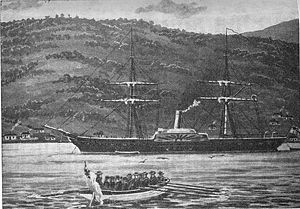Driver-class sloop
 HMS Driver
| |
| Class overview | |
|---|---|
| Name | Driver-class paddle sloop |
| Operators | |
| Preceded by | Template:Sclass- |
| Succeeded by | Template:Sclass- |
| Cost | Driver: £39,707[Note 1] |
| Built | 1840-1846 |
| In commission | 1841–1870s |
| Completed | 10 |
| Retired | 12 |
| General characteristics [1] | |
| Class and type | Driver-class wooden paddle sloop |
| Displacement | 1,590 tons |
| Tons burthen | 1,055 62/94 bm |
| Length | 180 ft (54.9 m) (gundeck) |
| Beam | 36 ft (11.0 m) |
| Depth of hold | 21 ft (6.4 m) |
| Installed power | 280-300 nhp (except Devastation and Sphinx) |
| Propulsion |
|
| Sail plan | Brig-rigged |
| Complement | 149 (later 160) |
| Armament |
|
The Driver class were a class of paddlewheel steam sloops of the British Royal Navy. Six Driver-class ships were ordered in 1840[2] and a further ten in March 1841, although only six were built. Five were ordered in 1847, but all were either build as paddle frigates or cancelled.[1]
Design
The ships were designed by Sir William Symonds. They were built of wood, displaced 1,590 tons and had a length on the gundeck of 180 feet (54.9 m).[1]
Propulsion
Power was provided by a two-cylinder direct-acting steam engine driving paddle wheels. Spiteful had a side-lever steam engine, Devastation had a 4-cylinder 'Siamese' steam engine and Sphinx had a 2-cylinder oscillating steam engine. The engines developed between 280 and 300 nominal horsepower, apart from Devastation (400 nhp) and Sphinx (500 nhp). All the ships were capable of about 9 knots (17 km/h) under steam, with the more powerful Devastation and Sphinx making 10 or 12 knots.[1] A brig rig was fitted for operating under sail.
Armament
All three ships were armed with two 10 in (250 mm) (84 cwt) guns on pivot mounts, two 68-pounder (64 cwt) guns and two 42-pounder (22cwt) carronades.[Note 2][1] In 1856 the armament was changed to a single 10-inch pivot gun, a 68-pounder (95cwt) gun and four 32-pounder (42 cwt) guns. Later, the 68-pounder was replaced by a 110 pdr Armstrong gun breech-loading gun.[1]
Crew
They had a complement of approximately 149 men, increasing later to 160.[1]
Ships
| Name | Ship builder[1] | Laid down[1] | Launched[1] | Commissioned[1] | Fate[1] |
|---|---|---|---|---|---|
| Driver | Portsmouth Dockyard | June 1840 | 24 December 1840 | 5 November 1841 | Wrecked on Mayaguana Island in the West Indies on 3 August 1861 |
| Styx | Sheerness Dockyard | 22 June 1840 | 26 January 1841 | 4 October 1841 | Broken up 1866 |
| Vixen | Pembroke Dockyard | June 1840 | 4 February 1841 | 28 December 1841 | Broken up 12 November 1862 |
| Devastation | Woolwich Dockyard | 27 July 1840 | 3 July 1841 | 30 November 1841 | Broken up September 1866 |
| Geyser | Pembroke Dockyard | August 1840 | 6 April 1841 | 8 March 1842 | Broken up 1866 |
| Growler | Chatham Dockyard | January 1841 | 20 July 1841 | 9 March 1842 | Broken up at Portsmouth by January 1854 |
| Thunderbolt | Portsmouth Dockyard | April 1841 | 13 January 1842 | 8 February 1843 | Wrecked on Cape Recife, Algoa Bay, South Africa 3 February 1847 |
| Cormorant | Sheerness Dockyard | 17 May 1841 | 29 March 1842 | 28 June 1843 | Broken up at Deptford by August 1853 |
| Spiteful | Pembroke Dockyard | August 1841 | 24 March 1842 | 24 March 1843 | Sold September 1883 |
| Eclair | Woolwich Dockyard | August 1841 | 31 May 1843 | 9 September 1844 | Originally Infernal (renamed 26 August 1844 before commissioning. Renamed Rosamund 14 October 1846. Floating factory 1863. Broken up 1865 |
| Virago | Chatham Dockyard | 15 November 1841 | 25 July 1842 | 29 July 1843 | Broken up at Chatham November 1876 |
| Sphinx | Woolwich Dockyard | May 1844 | 17 February 1845 | 3 November 1846 | Broken up at Devonport September 1881 |
| Rattler | - | - | - | - | Ordered 1841, but changed to Template:Sclass-, then re-ordered as the screw sloop Rattler |
| Bulldog | - | - | - | - | Design lengthened, becoming the first ship of the Template:Sclass- |
| Inflexible | - | - | - | - | Built as Bulldog class |
| Scourge | - | - | - | - | Built as Bulldog class |
| Furious | - | - | - | - | Ordered in 1847 but then re-ordered as a paddle frigate |
| Magicienne | - | - | - | - | Ordered in 1847 but then re-ordered as a paddle frigate |
| Resolute | - | - | - | - | Ordered in 1847 but then re-ordered as a paddle frigate and finally cancelled in 1850 |
| Tiger | - | - | - | - | Ordered in 1847 but then re-ordered as a paddle frigate |
| Valorous | - | - | - | - | Ordered in 1847 but then re-ordered as a paddle frigate |
References
Notes
- ^ A total cost accounting for inflation of approximately £4,515,800 in today's money.
- ^ "cwt", or "hundredweight" refers to the weight of the gun itself. "42-pounder" refers to the weight of the ball fired.
